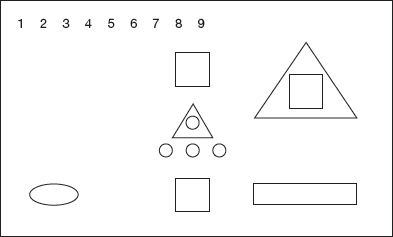Purpose Neville-Barton and Barton (2005) identified that ELLs often have difficulty with the sentence structures often used in mathematics. In particular, they identified conditionals, negation, prepositions, and word order as specific areas of difficulty. This strategy gives an example of how to teach the language of position and shape in an interactive task that requires both listening and speaking.
Procedure
Give instructions using mathematical terms to students, who draw what they hear. The aim is for close listening, so the drawing should be quick and simple.
Prepare a set of instructions that is appropriate for the level of the learners, uses simple visual terms, and has a series of steps.
- Read each step aloud to the class or group twice, allowing time for the drawing.
- After each step, ask the students to work in pairs to tell their partner what they drew and where they placed it.
- Have the students check their visual against the original.
- Put the sentences up for the students to see and highlight the positional language. Identify this language and link it to its visual representation in the original picture. Note which structures students had trouble with and plan to provide further support to help them learn this language.
Variations
- Have one or two confident students draw their pictures on the board so that the other students can copy when they are unsure.
- Ask one or two more confident or proficient students to give an instruction to the other students.
- Picture dictations can be done in pairs, one student reading and one drawing.
Sample instructions to read to students
- Draw a small triangle in the middle of your page.
- Draw a circle in the triangle.
- Above the triangle, draw a square.
- At the bottom of the page on the left, draw an oval.
- At the bottom of the page on the right, draw a rectangle.
- Between the oval and the rectangle, draw a square.
- Write the numbers 1–9 across the top of your page.
- Draw three circles under the triangle.
- On the right of the page at the top, draw a big triangle.
- In the big triangle, draw a square.
Sample picture
What to look for:
- What positional language do students understand?
- What positional language don’t they understand?
- Are there terms that the students confuse with one another?
- What do I need to teach explicitly?
- Which students were able to correctly describe (orally) where they had drawn shapes?
- Which language structures did students have difficulty articulating or constructing?
- Who was able to construct an instruction independently to give to the other students? Was it grammatically correct? If not, what parts of the structure were difficult for the student?
Back to Resource 4: Strategies for teaching mathematical language to English language learners
